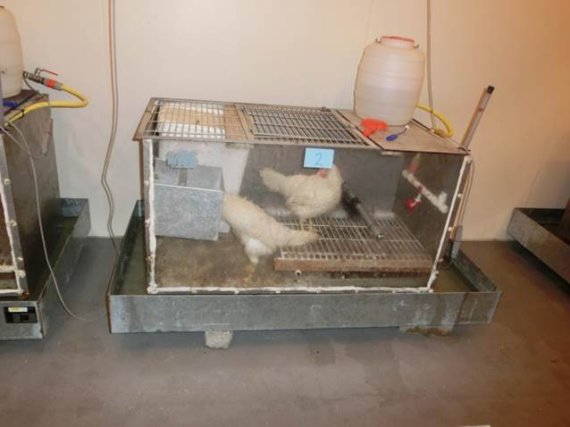<test situation to count poultry mites, photo Monique Mul>
The poultry mite, also known as the red poultry mite, is the most important cause of disease in laying hens worldwide. This small vampire hides in cracks and holes in poultry sheds and at night, when the hens go to roost, it creeps via their perches to the hens’ necks for its meal of blood. A population of poultry mites can quickly multiply in the shed – just one mite can produce 2600 offspring. The poultry mites reduce the hens’ resistance, spread diseases and, in extreme causes, result in death. The Dutch poultry sector estimates that the mite results in an annual cost of 35 cents per hen.
Restaurant
The poultry mite counter fits into the integrated pest management of this mite. Mul studied preventative measures aimed at avoiding a plague. Without a good monitoring system – a mite counter – the development and management of a mite epidemic are difficult to determine. Mul developed a detection box that works well in actual practice. A company is currently testing and upscaling a prototype of this counter. .
The principle behind the counter is a simple one. Mul: ‘The poultry mite has a hotel, a crack in the shed, and a restaurant, the hen’s neck. We have to catch them between the hotel and the restaurant.’ Because the vampire often reaches the hen via the stock, the square device is placed in a PVC shell under the stock. There is a small hole in the plastic shell, and a processor produces warmth. The poultry mites, attracted by the warmth, crawl into the device and are then counted by a sensor. ‘In a trial situation, the counter measured 1 to 2 percent of the population in the shed,’ Mul said. ‘This enables us to determine the total number of poultry mites. It is a good indicator of whether the epidemic is growing or decreasing.’
Pest management
The poultry sector is aware of the advantages of the vampire counter, Mul stated. Poultry farmers often find it difficult to follow the development of a mite epidemic. Nor do they know how well or for how long a pesticide against poultry mites is effective. With the poultry mite counter they can more effectively manage this problem. The research was paid for by the Commodity Board for Poultry and Eggs and the Ministry of Economic Affairs.
Mul thinks that more sectors would be interested in a fully automatic pest counter. ‘Dutch horticulturists use scouts who monitor the development of plagues in greenhouses. For example, they check the outbreak of spider mites. Using our methodology, we should be able to make a spider mite counter and a trip counter.’
Monique Mul will receive her PhD on 13 January with Peter Groot Koerkamp, professor of Agrotechnology

